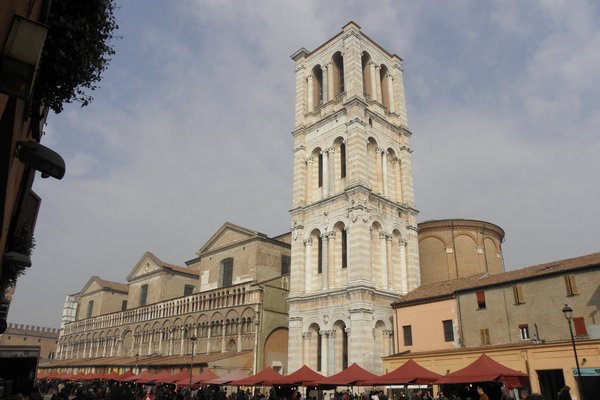Italy
Ferrara
Ferrara, City of the Renaissance, and its Po Delta are the first examples of Italian Renaissance town planning and its influence on the landscape.
In the late 15th century, the plan of the medieval city was redesigned and extended based on a complex urban plan on the orders of the ruling Duke Ercole d'Este I. Ferrara at that time grew into a cultural center, renowned for music as well as for visual arts. The Este family also carried out extensive land reclamation and building projects in the Po Delta, culminating in a network of noble residences.
Community Perspective: Ferrara has a certain charm, and it’s a university town so there is liveliness. Highlights here include the Palazzo Diamanti, the smaller Palazzo Marfisa d'Este, and the frescoes of the Palazzo Schifanoia. You can also cycle on the city wall. Some elements of the included Po Delta have been described by John.
Site Info
Official Information
- Full Name
- Ferrara, City of the Renaissance, and its Po Delta (ID: 733)
- Country
- Italy
- Status
-
Inscribed 1995
Site history
History of Ferrara
- 1999: Extended
- 1999: Name change
- From "City of Ferrara" to "Ferrara, City of the Renaissance and its Po Delta"
- 1999: Revision
- Includes former TWHS Pomposa Abbey (1984)
- 1999: Revision
- Includes former TWHS the Po Delta (1982)
- 1995: Inscribed
- Inscribed
- Type
- Cultural
- Criteria
- ii
- iii
- iv
- v
- vi
Links
- UNESCO
- whc.unesco.org
- Official
-
- ferrarainfo.com — Tourist portal of Ferrara
- Related
-
- castelloestense.it — The Este Ducal delizie (princely residences)
All Links
UNESCO.org
- whc.unesco.org — whc.unesco.org/
Official Website
- ferrarainfo.com — Tourist portal of Ferrara
Related Resources
- castelloestense.it — The Este Ducal delizie (princely residences)
Community Information
- Community Category
- Human activity: Urban planning
Travel Information
Emilia-Romagna and Marche Hotspot
Recent Connections
-
Gioachino Rossini
Teatro Comunale: "The theatre is noted …
-
Perfect Inscriptions
1995 -
Built or owned by French
Joannon de Saint Laurent designed the C…
Connections of Ferrara
- Individual People
-
-
Nicolaus Copernicus
Received his doctorate in canon law (1503). -
Gae Aulenti
In 2004, the restoration of the Castello Estense was completed with the inauguration of the €1.7m new museum display ideated by Gae Aulenti.See en.wikipedia.org
-
Charlemagne
In 774, the Frankish king Charlemagne, after defeating Desiderius, the last king of the Lombards, donated the city of Ferrara and its territory to the Holy See.See it.wikipedia.org
-
Napoleon was here
In 1796 Napoleon met Cardinal Alessandro Mattei in the Palazzo Arcivescovile.See it.wikipedia.org
-
Gioachino Rossini
Teatro Comunale: "The theatre is noted for staging the premiere of an early opera written by Gioacchino Rossini at the age of twenty, "Ciro in Babilonia" in March 1812." (Wikipedia)
-
- Geography
-
-
Adriatic Sea
Po-Delta (Mesola) -
River deltas
Po Delta -
Lowest (below sea level)
Bosco Mesola is located at approximately -1 m below sea level.See it.wikipedia.org
-
- Trivia
-
-
Dubbed as another WHS
Comacchio is dubbed Little Venice / The Delizia di Belriguardo was the summer palace of the Este court which, having been built in 1435, was the first summer residence of a lordship in Europe. It has also been defined as the "Versailles of the Este family".See it.wikipedia.org
-
Built or owned by French
Joannon de Saint Laurent designed the Chiesa della Natività di Maria Santissima in Mesola.See it.wikipedia.org
-
Discovered from the Air
"The archaeological finds from the burials of Spina were discovered with the help of aerial photography. Aside from the white reflective surfaces of the modern drainage channels there appeared in the photographs a ghostly network of dark lines and light rectangles, the former indicating richer vegetation on the sites of ancient canals. Thus the layout of the ancient trading port was revealed, now miles from the sea, due to the sedimentation of the Po delta." (wiki)See en.wikipedia.org
-
- History
-
-
Located in a Former Capital
Duchies of Modena and Ferrara -
The Inquisition
The Tribunal of the Inquisition was located in San Domenico and judicial procedures, sentences and often executions were held here.See it.wikipedia.org
-
Etruscans
Etruscan necropolis of Spina near Comacchio -
Assassinations
"On 3 May 1385, the Ferrarese people, driven to desperation by taxes and flooding that had brought ruin upon them, took themselves to the Marquis Niccolò II d'Este's palace to ask the advice of Tommaso da Tortona, the high official held to be responsible for this grave situation. Nicolò tried to calm the revolt all day, but by the evening it was clear that the people's spirits were getting more and more angry and that the very safety of the Estensi was endangered. The order was therefore given to summon the disgraced Tommaso, who was given confession and communion and then given to the crowd, who literally tore him to pieces." (Wikipedia)See en.wikipedia.org
-
Contains significant structures from the 20th Century
The Torre della Vittoria, adjacent to the Palazzo Municipale, was reconstructed in 1924-1928, centuries after the collapse of the tower previously located in the same position because of the 1570 earthquake.See en.wikipedia.org
-
Sieges and Battles
During the War of Ferrara, Ferrara was besieged by Venice.See en.wikipedia.org
-
Republic of Venice
Comacchio was part of the Republic of Venice between 1508 and 1598 -
Byzantine Empire and Civilization
The Curtensi Castle was the ancient Byzantine Castrum of Ferrara, the first medieval nucleus of the city. A first fortified nucleus in Ferrara existed at least until the end of the 6th century, and was located north of the first Ferrara basilica, on the left bank of the Volano branch of the Po. The Byzantines built a castrum to defend the main ferry that connected the island formed by the two branches of the Po with the territory to the north, and this defensive structure was surrounded by a moat. (Wikipedia)See it.wikipedia.org
-
Popes
Pope Urban III died in Ferrara in 1187 and is buried in the Cathedral of Saint George.See it.wikipedia.org
-
Knights Templar
The historian Marco Antonio Guarini claims that the church of San Giacomo was built by the Pagano (or Pagani) family who had just arrived in Ferrara. The family had among its ancestors the first grandmaster of the Knights Templar Ugo dei Pagani, and the historian states that the founder of the Order of the Temple is buried in the church of San Giacomo.See it.wikipedia.org
-
Knights Hospitaller
From 1826 to 1834 the Chiesa di San Giovanni Battista was governed by the Sovereign Military Order of Malta who had moved to Ferrara.See it.wikipedia.org
-
- Ecology
-
-
Turtles and tortoises
The European pond turtle and Hermann's tortoise in the Regional Park of the Po Delta.
See it.wikipedia.org
-
Flamingos
There are flamingos in the Po Delta Regional Park.See en.wikipedia.org
-
Salamanders
The Italian crested newt in the Regional Park of the Po Delta.See it.wikipedia.org
-
Lagoons
The lagoons of Comacchio (1999 AB Ev)
-
- Architecture
-
-
Urban fabric
"The originality of the urban fabric of Ferrara, along with its Renaissance design and layout elements, makes it a clearly recognisable Renaissance city." (Official description) -
Mannerism
The façade of the Palazzo BentivoglioSee it.wikipedia.org
-
Ideal City
"The humanist concept of the 'ideal city' came to life here in the neighbourhoods built from 1492 onwards by Biagio Rossetti according to the new principles of perspective." (Official description) -
Brick architecture
Many of the buildings in Ferrara are made with brick. "The Palazzo Schifanoia (...) has a long brick facade with a marble portal bearing the arms of the commanderv, the work of Ercole de' Roberti." (1995 AB Ev) + Castello Estense (Wikipedia)See en.wikipedia.org
-
Spolia
In the center of the Cathedral stands the main altar, consecrated in 1728. It is the work of Celio Tirini, who reused marble from buildings in Ravenna, mostly deriving from the ruins of King Theodoric's Palace of Ravenna.See it.wikipedia.org
-
Romanesque
Pomposa Abbey, Ferrara Cathedral -
Pre-Romanesque
Basilica di Pomposa -
Gothic
"Different from the entirely Romanesque façades of Modena and Parma Cathedrals, the upper parts of that in Ferrara show Gothic forms, already beginning in with the peaked arches comprising the triple round arches of first gallery."See en.wikipedia.org
-
English garden
Massari Park: the name of the park comes from the Massari counts who purchased the palace that bears their name and, later, transformed the pre-existing garden into an English park.See it.wikipedia.org
-
Renaissance
-
Designed by Pirro Ligorio
According to historians, the façade of the Palazzo Bentivoglio was designed by Ligorio.See it.wikipedia.org
-
Baroque
Chiesa dei Teatini, Palazzo Paradiso, San Carlo BorromeoSee en.wikipedia.org
-
Designed by Leon Battista Alberti
The unfinished Renaissance bell tower of the cathedral is attributed to Leon Battista Alberti and was built in 1451-1493.See en.wikipedia.org
-
Italian Renaissance garden
The garden of the Palazzo Costabili is not the original one, as it is a reconstruction in the style of a typical Renaissance garden carried out in the 1930s.See it.wikipedia.org
-
- Damaged
-
-
Damaged in World War II
"During World War II", the Castello Estense "was severely damaged by Allied aerial bombing, thus it was partially reconstructed in 1946." The Teatro Comunale also suffered badly.See en.wikipedia.org
-
Destroyed or damaged by Earthquake
1570See en.wikipedia.org
-
Destroyed during invasion
Comacchio was destroyed by the Venetians in 854
-
- World Heritage Process
-
-
Perfect Inscriptions
1995 -
Extended
1999: to include the Este ducal residences in the Po Delta and the cultural landscape of the Po Delta -
Cultural landscape not recognized
1999 extension in AB ev described as cultural landscape - crit v of the inscription even says "The Po Delta is an outstanding planned cultural landscape"
-
- Religion and Belief
-
-
Religious Relics
The relics of San Leo are preserved in the right nave of the church of Santo Stefano.See it.wikipedia.org
-
Jewish religion and culture
Synagogue and jewish cemetery -
Benedictines
Pomposa Abbey -
Carthusian Order
Certosa San CristoforoSee en.wikipedia.org
-
Augustinian Order
Sant'Antonio in Polesine is a Benedictine monastery "founded in the early Middle Ages by Augustinian hermits". (Wikipedia)See en.wikipedia.org
-
Dominican Order
Chiesa di San DomenicoSee it.wikipedia.org
-
Carmelites
The church of San Paolo was entrusted from 1295 to the Order of the Blessed Virgin of Mount Carmel.See it.wikipedia.org
-
Female Christian Mystics
Saint Catherine of Bologna "was raised at Niccolo III's court as a lady-in-waiting to his wife Parisina Malatesta and became lifelong friends with his natural daughter Margherita d'Este (...) In 1426, (...) Catherine left court and joined a lay community of beguines (...) In 1431 the beguine house was converted into the Observant Poor Clare convent of Corpus Domini, which grew from 12 women in 1431 to 144 women by the end of the century. Catherine lived at Corpus Domini, Ferrara most of her life from 1431 to 1456, serving as Mistress of Novices. She was a model of piety and reported experiencing miracles and several visions of Christ, the Virgin Mary, Thomas Becket, and Joseph, as well as future events, such as the fall of Constantinople in 1453."See en.wikipedia.org
-
Franciscan Order
Chiesa di San FrancescoSee it.wikipedia.org
-
Hercules
Above the entrance of the Palazzo Prosperi-Sacrati, situated on the Quadrivio degli Angeli, there are two tondos, in one of which the bust of Hercules is visible wearing the skin of the Nemean lion, a clear reference to Ercole I d'Este.See it.wikipedia.org
-
Jesuit Order
Chiesa del GesùSee it.wikipedia.org
-
Legends and Folk Myths
According to a widespread local legend, the devil left his goat footprint in the stone of the side portal because some of his protégés were condemned here, but another story is also told, linked to the magician Chiozzino. The hydraulic engineer Bartolomeo Chiozzi, who actually existed, is said to have made a pact with the devil and that, to break this pact, he asked for the help of the Dominican fathers of the church. Chiozzi, nicknamed the magician Chiozzino, managed to save himself, while the devil, out of anger, left his goat footprint on the side entrance of the church.See it.wikipedia.org
-
Marian Shrines
The Sanctuary of Santa Maria in Aula Regia in Comacchio. On the altar there is an altarpiece represented by a statue dedicated to the Blessed Virgin, in terracotta, from the Renaissance period. This work, venerated by the citizens with the title that gives its name to the sanctuary, is the protector of the city.See it.wikipedia.org
-
Nunneries
The Corpus Domini Monastery was founded in 1406. Saint Catherine of lived at the monastery most of her life from 1431 to 1456. The number of nuns progressively increased until it exceeded one hundred. Popular devotion, thanks to donations, allowed the construction of new buildings. Giovanni Romei, a banker linked to the Este family, donated his palace which stood a short distance away (Casa Romei) to the convent and in this way the religious complex reached the size of an entire city neighbourhood.See it.wikipedia.org
-
Cathedrals
Bas Cat di S Giorgio -
Servite Order
Chiesa di Santa Maria dei Servi, built for the Order of the Servites of MarySee it.wikipedia.org
-
Theatines
Chiesa dei TeatiniSee en.wikipedia.org
-
- Human Activity
-
-
Salt
"Comacchio was a major salt producer, but its expansion was halted by the depredations of the Venetians." (1999 AB Ev) The contest over the commerce of salt was also one of the reasons of the War of Ferrara, also called the Salt War (1482-1484), between Ferrara and the Papal Forces, allied with Venice.See en.wikipedia.org
-
Rice cultivation
"...cultivated lands dominated by rice farming" in the Po DeltaSee en.unesco.org
-
Musical Notation
Pomposa Abbey is where Guido d'Arezzo invented the staff notation. -
Historical Financial Institutions
The Cassa di Risparmio di Ferrara was a savings bank founded in 1838 in Ferrara. The bank was the fourth oldest Italian savings bank after those of Rome, Spoleto and Bologna. It was liquidated as a bad bank in 2015.See it.wikipedia.org
-
Invention of sweets and pastries
Zuppa inglese: "The origins of zuppa inglese are uncertain. One theory states that it originated in the sixteenth-century kitchens of the Dukes of Este, the rulers of Ferrara. According to this story, they asked their cooks to recreate the sumptuous "English trifle" they had enjoyed in England at the Elizabethan court, where they were frequent visitors. However, no recipes for the dish are recorded before the late nineteenth century".See en.wikipedia.org
-
Irrigation and drainage
"Transformations made to the countryside surrounding Ferrara during the Renaissance included: drainage of huge swathes of swampland, (...) creation of new waterways and streets as part of the overall urban development plan (...). (Official description) "The Este (...) undertook vast irrigation and reclamation projects to increase the amount of land available for farming (...). All the waterways were kept under supervision and managed by the construction of attractive villas, known as delizie, at key points in the network, often associated with hydraulic equipment or a farm building." (1999 AB Ev) -
Vineyards
The name of the Via delle Vigne comes from the land that in past centuries belonged to the Montagnola Gardens, later abandoned and then cultivated as vegetable gardens and vineyards.See it.wikipedia.org
-
Hunting Lodge or Castle
The Castle of Mesola was used by the Este family as a residence during hunting trips in the vast adjacent enclosed park.See it.wikipedia.org
-
Traditional sports and games
Palio di Ferrara - The Palio di Ferrara is a competition between the eight districts of Ferrara, made up of the four districts inside the medieval walls and the four villages outside. It constitutes the oldest palio in the world and is a historical re-enactment that originates from celebrations in 1259 with the return from Rome of Borso d'Este after receiving the duchy investiture from Pope Paul II.See it.wikipedia.org
-
Amber
Spina: "The city was at the southern end of the ancient Amber road from the Baltic sea. This trade was done through the Veneti, whose cities were to the north." (wiki)See en.wikipedia.org
-
Mints
"The city had been an important medieval centre, a free city with its own laws and even its own mint (...)." (Official description) -
Hermitage Museum
dependency in Palazzo Estense -
Aquaculture
"Comacchio is still cultivating eels in the traditional manner, although now this is also presented as part of the tourist attractions of the place." (1999 AB Ev) -
Polders
Poldered parts of the Po Delta are situated within the inscribed area (Wiki cites the "Delta of the river Po such as Bonifica Valle del Mezzano" in its list of Polders.) -
Shipwrecks
"the discovery of wrecks such as the famous Fortuna Maris, found near Comacchio" (1999 AB Ev) -
River Ports
"Ferrara grew up along the banks of the Po on the Roman road leading to Padua round a ford. When threatened by the Huns the Bishop of Voghenza moved his episcopal see to the right bank of the river and, to ensure his protection the exarchs of Ravenna built a fort on the opposite bank in the 8th century. A river port grew up on both banks round the fort and the bishop's establishment." (1995 AB Ev) In 1152 the Po diverted its course following Ficarolo's rout and made the city port, which had been very important until then, unusable, permanently changing the city's trade and causing it to fall into a period of economic crisis.See it.wikipedia.org
-
- Constructions
-
-
Notable Bridges
"The Ponte dei Trepponti or Trepponti bridge is a masonry arch bridge in Comacchio, Italy. It spans the Palotta canal, which splits up underneath it. The Trepponti bridge is a rare example of a five-way multi-way bridge."See en.wikipedia.org
-
Cemeteries
Monumental cemetery of the Ferrara CharterhouseSee it.wikipedia.org
-
Theatres and Opera Houses
Teatro ComunaleSee en.wikipedia.org
-
Necropolises
Etruscan necropolis of Spina near Comacchio -
Freestanding Bell Tower
The bell tower of the Duomo of ComacchioSee it.wikipedia.org
-
Dynastic Burial Places
The monastery of Corpus Domini, founded in 1406, has traditionally been the main burial place of members of the Este family in the citySee it.wikipedia.org
-
Loggia
"The casa Romei was built in 1442 for the banker husband of an Este princess, in the centre of the addizione of Niccolo II (1386). (...) It is oriented on two arcaded courtyards and loggias decorated with paintings, which open on to halls that have retained part of their interior decoration, such as the Hall of the Sibyls." (1995 AB Ev) + The loggias of the Cathedral, such as the gothic loggia above the main portal and the loggias on the south side.See it.wikipedia.org
-
Tombs
The tomb of the Italian poet Ludovico Ariosto in the Palazzo ParadisoSee en.wikipedia.org
-
Hospitals
The "Arcispedale Sant'Anna di Ferrara" Hospital, now outside the city, was originally founded in 1445 on the site of an ancient monastery of Augustinian friars from Armenia to which an oratory dedicated to Sant'Anna was linked. This was the first seat of the hospital, situated in the Piazzetta Sant'Anna. In 1927, the Sant'Anna was moved to a new location in Corso Giovecca.See it.wikipedia.org
-
Unfinished constructions
Ferrara Cathedral: "The marble campanile attributed to Leon Battista Alberti was initiated in 1412 but is still incomplete, missing one projected additional storey and a dome, as it can be observed from numerous historical prints and paintings on the subject."See en.wikipedia.org
-
Prison
In the Castello Estense, prisons, located at moat level, are in the basement of the Leoni tower. The Este family locked up high-ranking people or prisoners who required particular surveillance, certainly not common prisoners who found their place in the prisons of the Palazzo della Ragione. In some cells it is still possible to recognize some traces left by the inmates such as graffiti written on the bricks of the wall.See it.wikipedia.org
-
Walled cities
-
Monumental Columns
In the centre of the Piazza Ariostea stands the sixteenth-century column designed by Ercole Grandi from Ferrara on which, since 1833, stands the statue of Ludovico Ariosto, the poet from whom the square takes its name.See it.wikipedia.org
-
Clock Tower
The clock tower of the Delizia della DiamantinaSee it.wikipedia.org
-
Equestrian Statues
At the square in front of the cathedral, there's a statue of Niccolo III d'Este seated on a horse. -
Canals
Canale San Nicolo-Medelana
-
- WHS on Other Lists
-
-
European Cemeteries Route
Certosa -
World Biosphere Reserves
The Po Delta biosphere reserve (2015)
-
- Timeline
-
-
Built in the 15th century
city plan (1492)
-
- WHS Hotspots
-
-
Emilia-Romagna and Marche Hotspot
Half hour by train
-
- Science and Technology
-
-
Astronomy and Astrology
The months' hall at the Schifanoia palace is one of the most important astrological representations of Renaissance with the orientalising depictions of the decans and the connections between signs and Olympic gods. It has been the subject of a seminal study by Warburg and his school.See en.wikipedia.org
-
Universities
The University of Ferrara was founded in 1391. (1995 AB Ev) It is located in various buildings around the city, e.g. Palazzo Bevilacqua Costabili, Palazzo Turchi di Bagno, Palazzo Paradiso. -
Botanical Gardens
University of Ferrara Botanic GardenSee en.wikipedia.org
-
Libraries
The Biblioteca Comunale Ariostea in the Palazzo ParadisoSee en.wikipedia.org
-
- WHS Names
-
-
Name changes
First, from "Ferrara: a city of Renaissance and of walls permanent system" to "Ferrara, city of the Renaissance". (1995 AB Ev) Then, with the extension in 1999, from "City of Ferrara" to "Ferrara, City of the Renaissance and its Po Delta". -
Named after a River
Po
-
- Literature & Film
-
-
Location for a classic movie
"The Garden of the Finzi-Continis" is set in Ferrara and used the city for exterior shots. The film won the Golden Bear and 1972 Academy Award for Best Foreign Language Film.See en.wikipedia.org
-
News
No news.
Recent Visitors
Visitors of Ferrara
- AC
- Adrian Turtschi
- Alberto Rodriguez Gutierrez
- Alexander Barabanov
- Alexander Lehmann
- Alex Goh
- A. Mehmet Haksever
- Ammon Watkins
- Ana Lozano
- Anna Wludarska
- Antonio J.
- Argo
- arnaugir
- Artur Anuszewski
- Aspasia
- Astraftis
- Atila Ege
- awestix
- AYB
- Badwater
- BaziFettehenne
- Bill Maurmann
- Bin
- BobSmithseestheworld
- Bodil Ankerly
- Bruno_Pires
- Caspar
- CeeMon
- Cezar Grozavu
- chenboada
- chenqtao
- Christer Sundberg
- Christoph
- Christravelblog
- Claire Bradshaw
- Clyde
- Crinion
- Cristina Erba
- Csaba Nováczky
- CugelVance
- cutecid
- Cyberczar
- Damientournay
- Dani Cyr
- Daniela Hohmann
- Daniel Chazad
- Dan Pettigrew
- dave wood
- David Berlanda
- DavidS
- Dimitar Krastev
- Dirk-pieter
- Dolemite92
- Dorejd
- Doubanjiang
- Dr. Caligari
- Dwight Zehuan Xiao
- Elia Vettorato
- Elis
- Els Slots
- Erfe91
- Erik Jelinek
- Errol Neo
- Eva Kisgyorgy
- Evgenii
- fabi-ddorf
- Fan Yibo
- Federico P.
- Feldhase
- Felicité
- Filip Murlak
- Filippo Ubaldi
- Flexiear
- Frédéric M
- Frederik Dawson
- FS
- Gary Arndt
- George Gdanski
- GeorgeIng61
- GerhardM
- Gernot
- giulio25
- grimloch
- Harald T.
- Harry Mitsidis
- Hasco
- henrik_hannfors
- Hubert
- Hurrvinek
- Iain Jackson
- Ilya Burlak
- Ingrid
- Ivan
- Ivan Rucek
- Jaakkotoivanen
- Jakob F.
- Jana and Matt
- janem
- Janina Lehmann
- Jan-Willem
- Jan Zimmermann
- Jarek Pokrzywnicki
- Jasam
- Javier
- Jawnbeary
- Jens
- Jezza
- João Aender
- JobStopar
- Joel on the Road
- John Smaranda
- Jonas Hagung
- Jonas Kremer
- jonstst
- Joyce van Soest
- KarenBMoore
- Karito Vies
- Ken DJ
- KentishTownRocks
- Klaus Freisinger
- Knut
- Krijn
- Krzysztof B
- kutasp
- La Concy
- Lara Adler
- Laurey
- LaVale
- Liamps91
- lindaann
- Lisu Marian
- ljowers
- Loic Pedras
- Luboang
- Lucio
- Ludvan
- Luis Filipe Gaspar
- Maciej Gil
- Malgorzata Kopczynska
- Małgosia Łupicka
- marcel staron
- MarcoB_0
- Martin
- Martinacurra88
- Martina Rúčková
- Marton Kemeny
- Matejicek
- Mateusz
- Mathijs
- MAURO PODDA PANI
- MaxHeAnouBen
- MaYumin
- MH
- MichaelH
- Michael Turtle
- Mikko
- Ming_9734
- MMM
- Mo-han Je
- Monica Tasciotti
- nan
- Nasebaer
- Nick M
- Nihal Ege
- Nolan B.
- Olli-Pekka Turunen
- opperpco3
- PabloNorte
- Patrik
- Paul Schofield
- Peltzi
- Peter Lööv
- Petteri
- Philipp Leu
- Philipp Peterer
- Pieter Dijkshoorn
- Piotr Wasil
- Porcho
- Purrfect
- Rafał Kałczuga
- Ralf Regele
- Ralf Rotheimer
- Randi Thomsen
- Reisedachs
- Remigiusz
- Reza
- Riccardo Quaranta
- Rick Ohm
- RobRos
- Roccobot
- Roger Ourset
- Roman Bruehwiler
- Roman Raab
- Sabrina Liebehentschel
- Samy G
- Sandmann15
- Schnitzel
- Sclowitz
- SDMArado
- Sebasfhb
- Sergio Arjona
- Shandos Cleaver
- Shijie ZHU
- shwabb1
- sime147
- SirLoydd
- Slavi
- Solivagant
- Sorel Americo
- Stanislaw Warwas
- Stijn
- Svein Elias
- Szabolcs Mosonyi
- Szabo Viktoria
- Szucs Tamas
- Tamara Ratz
- Taotao Chen
- Tarquinio_Superbo
- Thomas Buechler
- Thomas van der Walt
- Thorben
- Tim Allen
- Tinamu
- tony0001
- triath
- Tsunami
- Twobaconsandaboston
- usagi1974
- Valentina
- Vanessa Buechler
- WalGra
- Walter
- WILLIAM RICH
- Wojciech Fedoruk
- Xander Huang
- Xiquinho Silva
- Yevhen Ivanovych
- Yongcheng Liu
- Zhenjun Liu
- Zoë Sheng
- Zos M
Community Reviews
Show full reviews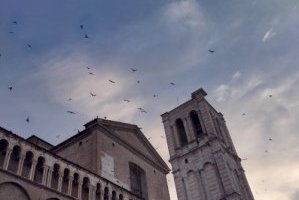
March 2023 - so far we had missed Ferrara on our trips. This time it was on the itinerary, as we wanted to complete Italy's WHS list. After we had lunch in Vicenza we drove partly Highway, partly on smaller roads towards our next Stop. South of the old town there is a large parking lot at the mura ferrara where we also spent the night in our campervan.
It was only a few minutes walk to the Castello and the Cattedrale. This evening we still had Gelato and Pizza on the hand and made a short walk through the old town. However, as it was Friday night, the bars filled up with more and more people, thus we decided to return to the Camper. I woke up at 6 next morning and decided to take another Walk through the center. Garbagemen were tyding up squeky clean.
I still visited the old ghetto and got some Coppia ferrarese, which actually do not taste like anything.
Three weeks later, on our way back north we crossed parts of the PO-Delta did not get the OUV of the area. though. In comparison the Risotto fields around Mantua seem way worthy.
Keep reading 0 comments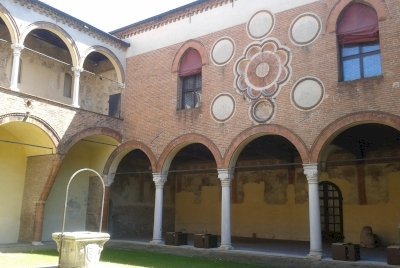
Ferrara was a surprise for me. I expected just another WHS Italian town, but it can be described as a flat urban landscape stuffed with monuments such as Duomo, Castello Estenze, Palazzo Diamanti and others monumental buildings and palaces. So, my advice how to enjoy such sites is to be lost in the streets and to be “shocked” by random finding of something exceptional – for example 15th century Casa Romei (PHOTO) with very nice courtyards, loggias and original wooden ceilings. The town is quite big, thus tourists are evenly scattered within the large area, which is very refreshing after visiting touristy spots like Florence.
Palazzo Diamanti and its neighborhood are also very nice. The gallery inside the palace was officially opened, but the cash desk was locked. So, it was possible to enter but not possible to buy a ticket… that was eventually OK for me as I enjoyed the façade decoration from outside only. I would not expect anything inside that would beat my impression from what I have seen outside. Duomo, at least from outside, is in quite a bad shape, it is covered by lichens and other flora, and seemed to collapse soon, and thus it is closed for visitors and under reconstruction. The main façade is hidden under scaffolding. As I saw magnificent cathedrals in Modena and Parma, I was not disappointed and enjoyed the narrow streets and palaces all around. It was also very interesting to see that the former ghetto with synagogue …
Keep reading 0 comments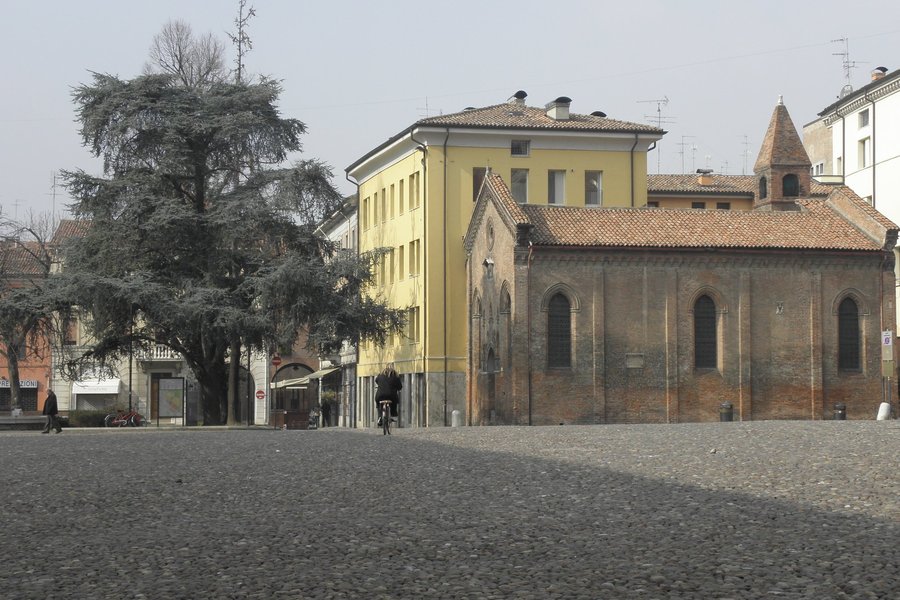
Ferrara is certainly one of the most livable cities in Italy, being the country's bicycle capital and having many green spaces. Its historic centre is quite interesting and pleasant, as well, but to me it did not appeal so much as a WH city. The cathedral and the Castello Estense, the city's landmark, are not bad (especially the moat), but nothing outstanding. I also saw the Palazzo dei Diamanti, famous for its unique wall, and the Palazzo Schifanoia, with its beautiful frescoes. To see the Po Delta part of the inscription, I took a bus out to Comacchio, a pleasant little town with a pretty Old Town and direct access to the canals and waterways that make up the delta. I just saw a small part of it, but I do believe that the Po Delta, as a unique cultural landscape, would easily stand on its own as a separate WH site, as I can't really see a very close connection to Ferrara (except for geographical reasons). Maybe then Ferrara should have been combined with Mantova as a pair of Renaissance towns.
Keep reading 0 comments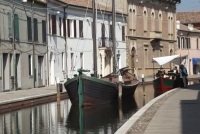
Finally I have succeeded in finding my way into the Po Delta area. I took a FER train from Ferrara to Codigoro to see the flood protection structures in the district.
I then took a bus to Commacchio, a picturesque town on the edge of its namesake lagoon. The lagoon is very popular with fishermen, but the town has a network of canals and bridges and a collection of restored medieval buildings. A veritable mini-Venice.
A combined bus/train journey brought me back to Ferrara.
Keep reading 0 comments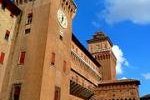
I visited this WHS in September 2012. The highlight of this medieval city is the Castello Estense. The visit inside is very informative and you get to see the dungeons where prisoners used to be kept. The mirrors are a great way to help illustrate the painted ceilings. The Cathedral and Palazzo dei Diamanti as well as Piazza Trieste are worth visiting too.
Keep reading 0 comments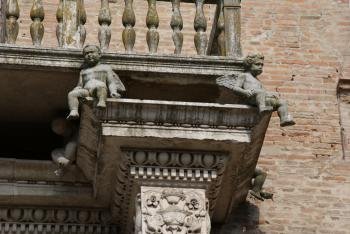
Ferrara is one of my favourite cities in northern Italy, although its buildings and churches are less outstanding compared to other cities such as Verona and Vicenza. The plan of the city and most of the historic buildings date from the 14th and 15th Century, when Ferrara was ruled by the Este family. The historic centre is dominated by the Castello Estense and the Gothic cathedral. The Castello has everything you'd expect from a medieval castle: drawbridges, a moat, towers, a dungeon. But the upper parts were reconstructed in the 16th Century, the battlements were replaced with terraces and balconies. Worth seeing are also the Palazzo dei Diamanti with its exceptional facade of pyramid-shaped blocks of marble (the interior picture gallery is not very interesting), the nearby Palazzo Prosperi with an portico decorated with putti (photo), the Palazzina Marfina d'Este, the Casa Romei, the Palazzo Schifanoia (wonderful frescoes in the Sala dei Mesi), the Via delle Volte, the outside staircase of the Palazzo Municipale, and the Cimitero della Certosa.
We liked best to ride by bike on the city wall that surrounds the whole historic centre and so we explored also the remote parts of the old city. Ferrara is known as a city of cyclists and bicycles are available in most hotels. Ferrara is a university town, and therefore has also a good night-life. If the weather is fine a trip to the Po Delta is worthwhile, especially if you like birdwatching. The best is to rent a bicycle …
Keep reading 0 comments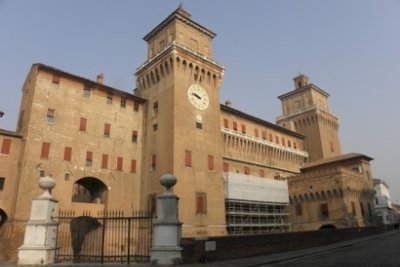
Ferrara has a certain charm and calmness, but I found it not up to par with great Italian cities like Verona, let alone Venice or Rome. The Michelin Green Guide gives it 2 stars (“worth a detour”), and that is about right. I stayed there for 2 nights, using it as a base for a day trip to Mantua also.
The various sights are scattered around the city center, showing the town’s various stages of development which are so crucial in its OUV of “Renaissance town planning”. To the east lie several small palaces, built by wealthy relatives and supporters of the ruling d’Este family. The Palazzina Marfisa d'Este for example is a villa with a garden that could be lovely if well-attended (I was visiting in winter so maybe it is nicer in spring or summer). There’s a loggia at the back, and the house’s interior has many decorated ceilings and period (or later) furniture. The nearby Casa di Romei is bigger, has two stories and houses a small museum.
At the heart of the city are the Cathedral and the Castle. Both have striking exteriors. In the interior of the Cathedral dark grey colours stand out – I was not too impressed with it. The Castle’s interior is quite barren too but is surely worth visiting. At the lower levels, the history of the city and the d’Este family is told via displays, and in another part, the frescoed ceilings are shown up-and-close via mirrors on …
Keep reading 0 comments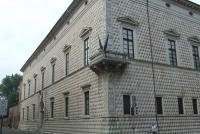
The WHS site includes several buildings from different periods. The Castello Estense and the Palazzo Municipale are from the medieval period, while the Palazzi Diamante, Guido d'Este and Turchi-di Bagno are typical buildings of the renaissance period.
Buses #1&9 link the station with the Castello Estense and the Parco Pareschi.
Keep reading 0 comments
I stayed in Ferrara for eight months as part of my BA Italian degreee and I really enjoyed it. The city was great, there are a lot of things to see. There are many places, but the best are the Palazzo Diamanti and the smaller Palazzo Marfisa d'Este. Other places of cultural interest are the two cathedrals- the gothic facade of San Giorgio is amazing, whilst the Castle is a reminder of the Este family who ruled Ferrara in the 15th century.
There are many parks to rest and enjoy the sunny weather, such as the wonderful Parco Massari, or the Piazza Ariostea where there is an annual racing event, the Palio, that dates back to the mediavel time.
Not only is Ferrara steeped in history, but it is close to many of the northern cities. Venice is only an hour away by Eurostar, whilst Padua, Mantua and Verona are easily within two hours. Florence is only under two hours away as well!
There are clubs and bars too, making Ferrara's night life good! There is always a restaurant or pizzeria around the city, offering good value for money.
Overall Ferrara is a great place to visit, or use as a stopping point to move onto somewhere else!
Keep reading 0 comments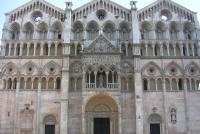
Spent a pleasant midday strolling around the Renaissance city of Ferrara. Really enjoyed the unusual cathedral (pictured) and the frescoes of the Palazzo Schifanoia. Most striking, however, is the city-planning: from the winding alleyways of the medieval old town to the grid-like streets of the Renaissance-era Herculanean Addition. Throw in some fantastic parks and impressive architecture and Ferrara makes a wonderful day trip for those in the Emilia-Romagna region.
Keep reading 0 comments
